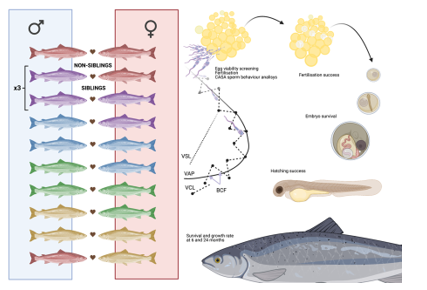INBREEDING AVOIDANCE AT THE GAMETE LEVEL IN ATLANTIC SALMON Salmo salar
Inbreeding can lead to fitness depression and reduce adaptive responses, and as consequence a range of mechanisms to limit reproduction between close genetic relatives have evolved. Here, we examine whether inbreeding avoidance exists between sperm and egg in Atlantic salmon, in a post-copulatory selection process where mechanisms are still to be unveiled. Philopatric salmon usually return to their natal streams to spawn, presenting a risk of breeding between genetic relatives, and reduced potential for females to control paternity under external fertilisation .
In a paired breeding design, we compared sperm motility parameters between sibling and non-sibling ovarian fluid, fertilisation and hatching success, growth rates and paternity outcomes following sperm competition trials between sibling and non-sibling males using microsatellites to assign paternity.
We found that sperm behaviour was significantly different in sibling vs. non-sibling reproductive fluid, with sperm activated in sibling fluid showing reduced motility and swimming trajectories coherent with a minor fertilisation potential. Males also suffered an average 18% reduction in fertilisation rates when crossed with eggs from sibling females, and sibling’s offspring attained lower bodyweights and lengths before the onset of sexual maturation , but similar survival rates w ere observed despite the grade of relatedness.
O ur sperm competition trials revealed no difference in relative
paternity success when simultaneously competing over the eggs of a sibling female and following this sibling hatched offspring showed consistently higher degrees of heterozygosity . We discuss possible reasons for this result in a context of balance between inbreeding avoidance mechanisms and preservation of local adaptation consistent with homing behaviour.
These findings indicate that post-copulatory inbreeding avoidance mechanisms have evolved at the gamete level in salmon, likely through interaction between ovarian fluid and sperm swimming , but also that sibling mates can equally contribute to overall paternity
after proper ‘filtering’ . Our results find relevant applications in conservation aquaculture and in improving salmon farming sustainability due to the high degree of inbreeding reported in this sector and to the risk of detrimental genetic interactions in the wild
as a result of farmed salmon escapes.
